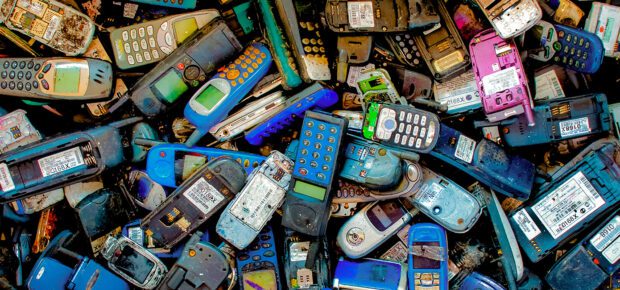April 18, 2023
The issue of electronic waste has become a significant concern in recent years. Consumers purchase and discard electronic devices at an unprecedented rate, leading to several environmental impacts. For example, smartphones contain small amounts of precious and rare earth metals, the mining of which often produces more waste than the amount of material recovered. The climate impacts of gathering raw materials, and of manufacturing and shipping millions of phones each year, is also significant.
At the same time, smartphones can be extremely expensive. Some models top $1,500, a sizable investment for a device that many people would only use for two years.
That’s where refurbishment of smartphones comes in. Consumers can get access to the latest and greatest smartphones for a fraction of the cost of buying new. And it extends the life of an otherwise unwanted phone without the additional environmental burden of manufacturing a new smartphone.
Refurbished smartphones are big business, with more than 300 million sold each year. But research shows that less than half of consumers would consider a refurbished phone, in part because they can’t be sure of the quality of the device.
A recent article in IEEE Access finds that, while smartphone recycling has sustainability benefits, a lack of clear standards leaves consumers at risk because refurbished phones may not be as reliable as new ones. The article calls for clear and transparent standards that consumers can rely on to make informed decisions.
“Today, if you purchase an item being sold as refurbished, you typically have no idea what you are getting,” said IEEE Senior Member Nicholas Napp. “The word ‘refurbished’ could mean that the device is ‘like new’, but was purchased by another consumer and returned. But refurbished could also mean that it has undergone some rudimentary servicing, from wiping the memory of a smartphone to replacing a missing manual or adapter.”
The article notes that the device manufacturers and third-party resellers are both involved in refurbishment of smartphones, but may have wildly different practices and benchmarks. While they may fix a central problem, they do not know the likelihood that other components will stop working. And they may use replacement parts that weren’t approved by the original manufacturer, or break seals meant to keep out moisture and dust.
Clear standards could help consumers build confidence in refurbished electronics products.
“Standardization in engineering is fundamental to creating methods that we know will work,” said IEEE Member Tiago Nascimento. “These methods can allow scalability. In the case of consumer electronics refurbishment, the scalability can lead to less trash and more use of technology that it has not reached yet.”
Governments are also passing “right to repair” laws, the goal of which is to make it easier to repair electronic equipment of all stripes – from smartphones to farm equipment.
“In practice, device designers weigh hundreds of considerations when creating new products, and reparability too often is far down the list,” said IEEE Senior Member Inderpreet Kaur. “Putting a publicly available service manual online by device designers will be a simpler way to improve ease of reparability.”
Learn more: In a recent edition of IEEE Computer Magazine, IEEE 2023 President Elect Thomas Coughlin argues that IEEE standards for data sanitization help to encourage electronics recycling and refurbishment.





 Why AI Can't Live Without Us
Why AI Can't Live Without Us Bits, Bytes, Buildings and Bridges: Digital-Driven Infrastructure
Bits, Bytes, Buildings and Bridges: Digital-Driven Infrastructure Impact of Technology in 2024
Impact of Technology in 2024 Emerging AI Cybersecurity Challenges and Solutions
Emerging AI Cybersecurity Challenges and Solutions The Skies are Unlimited
The Skies are Unlimited Smart Cities 2030: How Tech is Reshaping Urbanscapes
Smart Cities 2030: How Tech is Reshaping Urbanscapes Impact of Technology 2023
Impact of Technology 2023 Cybersecurity for Life-Changing Innovations
Cybersecurity for Life-Changing Innovations Smarter Wearables Healthier Life
Smarter Wearables Healthier Life Infrastructure In Motion
Infrastructure In Motion The Impact of Tech in 2022 and Beyond
The Impact of Tech in 2022 and Beyond Cybersecurity, Technology and Protecting Our World
Cybersecurity, Technology and Protecting Our World How Technology Helps us Understand Our Health and Wellness
How Technology Helps us Understand Our Health and Wellness The Resilience of Humanity
The Resilience of Humanity Harnessing and Sustaining our Natural Resources
Harnessing and Sustaining our Natural Resources Creating Healthy Spaces Through Technology
Creating Healthy Spaces Through Technology Exceptional Infrastructure Challenges, Technology and Humanity
Exceptional Infrastructure Challenges, Technology and Humanity The Global Impact of IEEE's 802 Standards
The Global Impact of IEEE's 802 Standards Scenes of our Cyber Lives: The Security Threats and Technology Solutions Protecting Us
Scenes of our Cyber Lives: The Security Threats and Technology Solutions Protecting Us How Millennial Parents are Embracing Health and Wellness Technologies for Their Generation Alpha Kids
How Millennial Parents are Embracing Health and Wellness Technologies for Their Generation Alpha Kids Space Exploration, Technology and Our Lives
Space Exploration, Technology and Our Lives Global Innovation and the Environment
Global Innovation and the Environment How Technology, Privacy and Security are Changing Each Other (And Us)
How Technology, Privacy and Security are Changing Each Other (And Us) Find us in booth 31506, LVCC South Hall 3 and experience the Technology Moon Walk
Find us in booth 31506, LVCC South Hall 3 and experience the Technology Moon Walk Virtual and Mixed Reality
Virtual and Mixed Reality How Robots are Improving our Health
How Robots are Improving our Health IEEE Experts and the Robots They are Teaching
IEEE Experts and the Robots They are Teaching See how millennial parents around the world see AI impacting the lives of their tech-infused offspring
See how millennial parents around the world see AI impacting the lives of their tech-infused offspring Take the journey from farm to table and learn how IoT will help us reach the rising demand for food production
Take the journey from farm to table and learn how IoT will help us reach the rising demand for food production Watch technical experts discuss the latest cyber threats
Watch technical experts discuss the latest cyber threats Explore how researchers, teachers, explorers, healthcare and medical professionals use immersive technologies
Explore how researchers, teachers, explorers, healthcare and medical professionals use immersive technologies Follow the timeline to see how Generation AI will be impacted by technology
Follow the timeline to see how Generation AI will be impacted by technology Learn how your IoT data can be used by experiencing a day in a connected life
Learn how your IoT data can be used by experiencing a day in a connected life Listen to technical experts discuss the biggest security threats today
Listen to technical experts discuss the biggest security threats today See how tech has influenced and evolved with the Games
See how tech has influenced and evolved with the Games Enter our virtual home to explore the IoT (Internet of Things) technologies
Enter our virtual home to explore the IoT (Internet of Things) technologies Explore an interactive map showcasing exciting innovations in robotics
Explore an interactive map showcasing exciting innovations in robotics Interactively explore A.I. in recent Hollywood movies
Interactively explore A.I. in recent Hollywood movies Get immersed in technologies that will improve patients' lives
Get immersed in technologies that will improve patients' lives